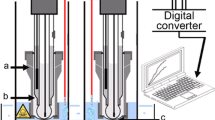Abstract
To analyze the extent of mineralization of trichloroethylene (TCE) without disturbing an actively growing biofilm, a minimal growth medium was formulated that reduces the concentration of chloride ions to the extent that the chloride ions generated from TCE mineralization may be detected with a chloride-ion-specific electrode. By substituting chloride salts with phosphates and nitrates, a chloride-free minimal medium was produced that yields a specific growth rate for Pseudomonas cepacia G4 PR1 which was 93% of that in chloride-ion-containing minimal medium. Furthermore, TCE degradation by resting cell suspensions was similar in both media (85% of 75 μM TCE degraded in 6 h), and complete mineralization of TCE was slightly superior in the chloride-free minimal medium (77% compared to 60% of 75 μM TCE mineralized in 6 h). In addition, indole-containing, minimal-medium agar plates were developed to indicate the presence of the TCE-degrading enzyme toluene ortho-monooxygenase (fire-engine-red colonies) as well as to distinguish this enzyme from other TCE-degrading enzymes (toluene dioxygenase and toluene para-monooxygenase).
Similar content being viewed by others
References
Ensley BD, Ratzkin BJ, Osslund TD, Simon MJ (1983) Expression of naphthalene oxidation genes in Escherichia coli results in the biosynthesis of indigo. Science 222:167–169
Folsom BR, Chapman PJ, Pritchard PH (1990) Phenol and trichloroethylene degradation by Pseudomonas cepacia G4: kinetics and interactions between substrates. Appl Environ Microbiol 56:1279–1285
Golovleva LA, Zaborina O, Pertsova R, Baskunov B, Schurukhin Y, Kuzmin S (1992) Degradation of polychlorinated phenols by Streptomyces rochei 303. Biodegradation 2:201–208
Jenkins RO, Dalton H (1985) The use of indole as spectrometric assay substrate for toluene dioxygenase. FEMS Microbiol Lett 30:227–231
Little CD, Palumbo AV, Herbes SE, Lidstrom ME, Tyndall RL, Gilmer PJ (1988) Trichloroethylene biodegradation by a methane-oxidizing bacterium. Appl Environ Microbiol 54:951–956
McFarland MJ, Vogel CM, Spain JC (1992) Methanotrophic cometabolism of trichloroethylene (TCE) in a two stage bioreactor system. Water Res 26:259–265
Murdock D, Ensley BD, Serdar C, Thalen M (1993) Construction of metabolic operons catalyzing the de novo biosynthesis of indigo in Escherichia coli. Biotechnology 11:381–386
Nelson MJK, Montgomery SO, Mahaffey WR, Pritchard PH (1987) Biodegradation of tricholoroethylene and involvement of an aromatic biodegradative pathway. Appl Environ Microbiol 53:949–954
Rodriguez RL, Tait RC (1983) Recombinant DNA techniques: an introduction. Benjamin/Cummings, Menlo Park, Calif
Shields MS, Reagin MJ (1992) Selection of a Pseudomonas cepacia strain constitutive for the degradation of trichloroethylene. Appl Environ Microbiol 58:3977–3983
Shields MS, Reagin MJ, Gerger RR, Somerville C, Schaubhut R, Campbell R, Hu-Primmer J (1994) Constitutive degradation of trichloroethylene by an altered bacterium in a gas-phase bioreactor. In: Hinchee RE, Leeson A, Semprini L, Ong SK (eds) Bioremediation of chlorinated and polycyclic aromatic hydrocarbon compounds, Lewis, Boca Raton, Fla pp 50–65
Sun AK, Wood TK (1995) Trichlorethylene degradation and mineralization by pseudomonads and Methylosinus trichosporium OB3b. Appl. Microbiol Biotechnol. (submitted)
United States Environmental Protection Agency (1984), Hazardous waste sites: description of sites on current national priorities list, October 1984.
Wackett LP, Gibson DT (1988) Degradation of trichloroethylene by toluene dioxygenase in whole-cell studies with Pseudomonas putida F1. Appl Environ Microbiol 54:1703–1708
Winter RB, Yen K-M, Ensley BD (1989) Efficient degradation of trichloroethylene by a recombinant Escherichia coli. Biotechnology 7:282–285
Yen K-M, Karl MR, Blatt LM, Simon MJ, Winter RB, Fausset PR, Lu HS, Harcourt AA, Chen KK (1991) Cloning and characterization of a Pseudomonas mendocina KR1 gene cluster encoding toluene-4-monooxygenase. J Bacteriol 173:5315–5327
Zylstra GJ, Gibson DT (1989) Toluene degradation by Pseudomonas putida F1. J Biol Chem 264:14940–14946
Author information
Authors and Affiliations
Rights and permissions
About this article
Cite this article
Luu, P.P., Yung, C.W., Sun, A.K. et al. Monitoring trichloroethylene mineralization by Pseudomonas cepacia G4 PR1. Appl Microbiol Biotechnol 44, 259–264 (1995). https://doi.org/10.1007/BF00164512
Received:
Revised:
Accepted:
Issue Date:
DOI: https://doi.org/10.1007/BF00164512




